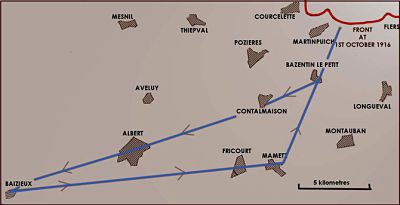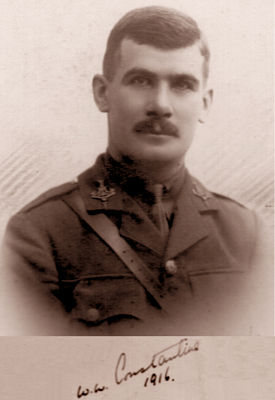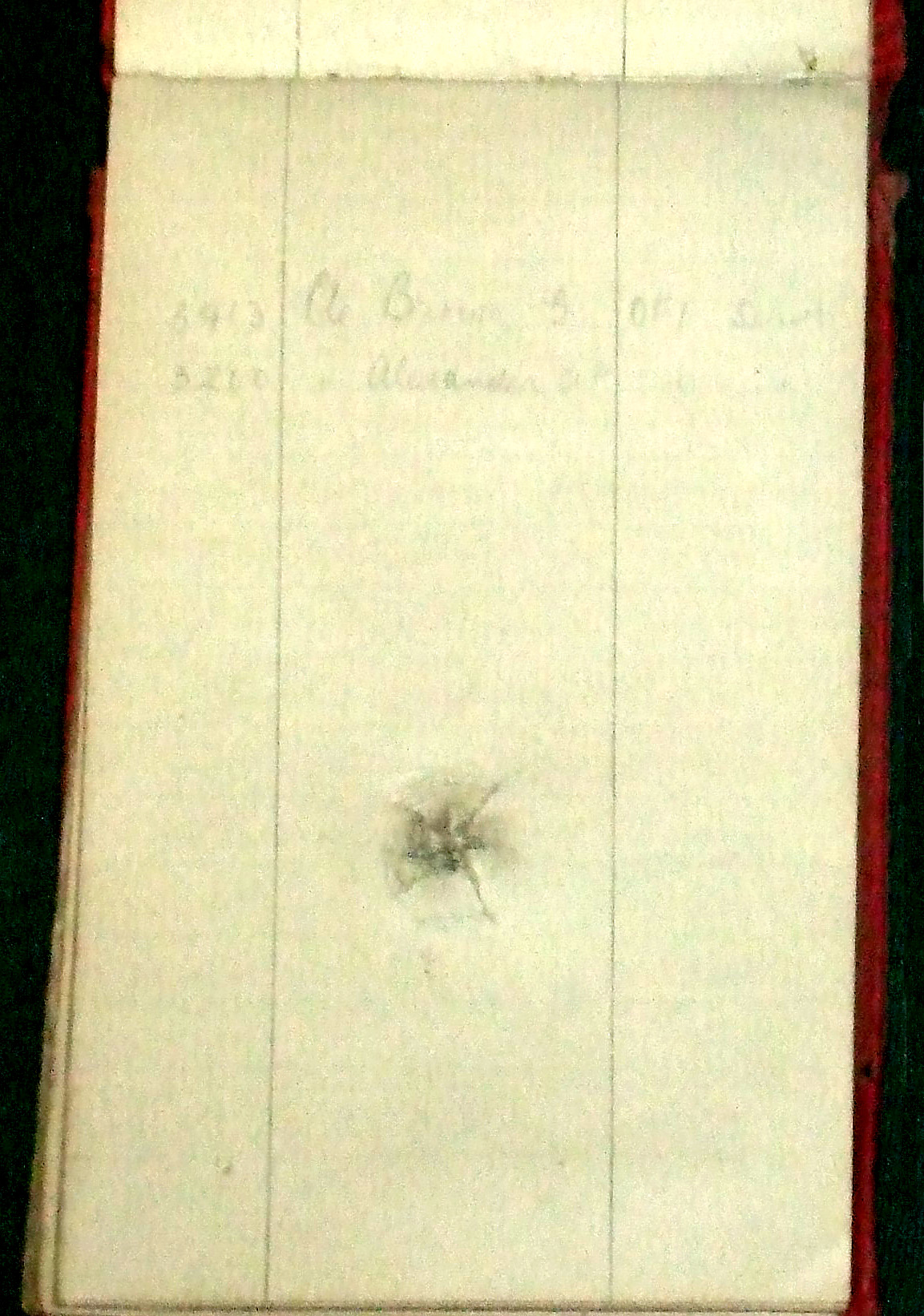
An 18 pounder British Field Gun.
A postcard of the day produced in London. People at home still tended to glamourise the War and its caption reads -
In the hands of a skilful crew it can fire so rapidly that 3 shots will be in the air at the same moment.
By automatic adjustment the gun does not need re-sighting after each shot.
[From postcard owned by this website.]
|
1st OCTOBER. The 151st Inf Bde were ordered to attack the Flers line at 3 p.m.
The 150th Inf Bde was
ordered to support and were ordered to move up. The Btn occupied Clarke's Trench and the Intermediately Trench.
Thus placing the Btn in the shelled area again and immediately in front of the Field Gun Batteries.
No possible
military advantage could have been secured by this move.
The Btn was scattered and suffering absolutely unnecessary
discomfort and casualties and was not able to be moved quickly had it been required.
1416 Pte Bell Joseph, Ray. Born Marske N Yorks and enlisted at Middlesbrough.
Died of wounds at home. Age 22. Buried at Middlesbrough Linthorpe Cemetery.
5162 Pte Bye Thomas. Born and enlisted at Middlesbrough, N Yorks. Died of wounds.
Commemorated on the Thiepval Memorial.
2nd OCTOBER. The Btn was sent back about 11 a.m. The whole Btn was ordered as a working party at 1 p.m to
repair roads.
This consisted chiefly in scraping mud off the roads and filling up shell holes with very inferior
bricks from Basentin Le Petit, which ground to mud again immediately after a single limber had passed over.
It poured with rain the whole day and no shelter was available for the men.
|

On the 3rd October 1916 the 4th Battalion moved via Albert to Baizieux for training.
By the 22nd they were back at the trenches near Martinpuich.
|
3258 Pte Green Gordon. Home at - Dalton Thirsk, place of enlistment. Died of wounds at home.
Age 19. Buried at Dalton [St John] Churchyard
3rd OCTOBER. The Btn moved to billets in Albert, where they had to wait in the rain for 2 hours while
Canadian troops vacated the building. However the billets were good and men were enabled to get dry and sleep on a
dry floor.
4th OCTOBER. The Btn moved to Camp in Baiseux Wood.
The Diary gives a summary of the casualties sustained since 15th Sept:-
Officers killed.
Capt T.S. Rowlandson. 2nd Lts R.B. Abrahams. W.J Hayton. H.N Laing. E.L. Perris. E Richardson.
Died of wounds, 2nd Lt R.S. Omand.
Wounded - Capt. W.W. Constantine.
|

|
Lt W.L. Batty. Lt T.G. Thornton. Lt J. Miller. Lt G.A Tugwell. Lt R.F. Williams [RAMC].
2nd Lts A.S. Brentnall.
C.B Prior Wandesforde. A.D Scott. M.W. Macnay. R.S. Forest. V.A. Bell. H.E. Aust.
J. Robson. C.J. Minister. H.L. Harrison. R.M. Howes. D.F. Hirsch. R.G. Scott. J.B. Hudson.
Other Ranks - Killed 64. Died of Wounds 8. Wounded 250. Missing 47.
Capt William Whitesmith Constantine. MC.
One of the three Constantine brothers of Harlsey Hall, East Harlsey, Northallerton who were all Officers in the Battalion.
He was born on the 26th March 1887 and educated at Uppingham and Clare College Cambridge before entering the family shipping
business.
He had joined the local 1st Volunteer Battalion of the Durham Light Infantry some time before 1908, as when the Territorial Force was
established on the 1st April of that year this Unit became part of the 4th Yorks Battalion. He was at that time a Lieutenant and
the London Gazette lists him among the Officers who were transferred.
He was a Battalion Capt at the start of the War and was forwarded for mention in Despatches for action on the
3rd May 1915 at Ypres, where he was among those gassed on the 24th May 1915.
He was wounded again, October 1916, and for his conspicuous gallantry at this time was awarded the Military Cross.
The London Gazette of the 14th Nov 1916:-
"Though wounded before the attack commenced, he insisted in leading his Company to the final objective, where, though
wounded again, he continued with the greatest determination to control his Company.
|

Capt Constantine was carrying this Nominal Roll Book when he was hit by a German Sniper.
The thickness of the pages saved his life.
|
He set a fine example."
When he returned to duty is not known. He was promoted to Major in January 1917 and appears to have held a position as a Staff Officer until
1918.
In August/September 1918 he was posted to the 9th Battalion of the King's Own Yorkshire Light Infantry as by this time the 4th Yorks had
ceased to exist as a fighting Unit. He was with they KOYLI only a short time before he was wounded for a third time.
After the War the 4th Battalion was re-formed and Major Constantine was promoted to Lt Col with them. He received the TD and Bar for
length of service.
In World War II he served in the Home Guard from 16 May 1940 to 31 Dec 1944 and received the Home Guard certificate and Defence Medal.
He also received the Danish award, the Order of Dannebrog Knight 1st Class, presumably when he was CO of the 4th Yorks TA in the
1920/30s
At some after the First War he was appointed Deputy Lieutenant for the North Riding.
His Grandson writes of him:-
He was an interesting man. Quiet, unassuming and kind. Notwithstanding his background and business in Shipping, he was good with people
and not overbearing or militaristic. He was deeply affected by WW1, but valued his friends and social life in the TA. Despite being badly
gassed and suffering chest problems, he was a heavy smoker till he died in 1970. He would never talk about his First World War experiences.
[Photograph and information kindly contributed by his Grandson, Christopher Constantine and Great Nephew
Simon Barnard.]
|

Lt Col W. W. Constantine's Medals.
|

St Sever Cemetery, Rouen.
Situated on the Southern outskirts of Rouen, the area was the base for several Hospitals during the
whole course of the War.
16 men of the 4th Yorks Battalion are buried here and in the Cemetery Extension.
[Picture courtesy of - "WW1Cemeteries.com".].
|
Diary - "Considering the ground won and the fact that the right flank was always in the air and on the night attack
on the 26th both flanks the casualties are not excessive."
5th OCTOBER. The day spent in refitting and reforming the Battalion. Men were bathed, but the shirts given
to them were "lousy and verminous and dirty."
6th OCTOBER. Training. Lewis Gunners and Bombers.
Men who were admitted to hospital wounded have been discharged back to the Battalion absolutely unfit for duty.
It is disgraceful that this should happen.
1481 Pte Allenby Percy, William. Enlisted at Middlesbrough, N Yorks. Died at home on the 6th.
Age 21. Buried at Middlesbrough in Linthorpe Cemetery.
3169 Pte Bainbridge Bewick. Home in Hutton Rudby, Yorks, Enlisted at Darlington,
Co Durham. Died of wounds on the 14th. Age 24. Buried at St Sever [Hospital] Cemetery Extension, Rouen
2774 Pte Dungay Edward, Arthur. Enlisted at
Middlesbrough, N Yorks. At the 1911 census he was lodging at 4 Robinson St, Middlesbrough with his wife Lilian and their two children,
Edward and William.
|
He was employed as a Labourer on the local Ironworks. His parents came from Norfolk.
Died of wounds on the 18th. Age 28. Buried at Etaples Military [Hospital] Cemetery.
Local newspaper:-
Mrs E. A. Dungay, of King's Lynn, late of Parliament St, Middlesbrough, has received the sad information that her husband, Pte E A Dungay, of the 4th Yorks, has died of wounds in hospital.
Previous to joining the Colours he was employed for some years at Messrs Storrow's, Dock St, Middlesbrough, as a blacksmith.
Letter to local newspaper:-
"Soldier's Wife" writes "will you kindly allow me space in regard to EO's letter on 'No Leave'.
I am a soldier's wife and I also protest against the treatment of our gallant lads of the 4th Yorks, as regards their leave.
My husband, I have not seen for 13 months. Twelve out of the 13 he has been in ------ and has not had any leave, nor is there any sign yet of a few days' leave, which I am sure, they deserve after so many month's hard fighting.
My husband has not even had a chance to get home to see our son, who is now 11 months old, which I think is very hard."
[My own Grandfather went out to France when the 4th Yorks first went on 18th April 1915 and between then and the 15th January 1917, when he died of wounds, he had one week's leave in the UK. Some went longer than that.]
Local newspaper:-
Corporal J W Sheldon of Loftus, N Yorks who went through it all, has sent the following for publication:-
BRIGADIER'S THANKS TO THE GALLANT 4TH YORKS.
To all ranks of the 4th Yorkshire Regiment.
The Brigadier-General commanding has asked me to express to the Officers, N.C.O.s and men of the Battalion his very great appreciation of their gallantry during the recent operations.
The casualties testify to the severity of the fighting; they not only took and held all objectives, but also reformed and took two more trenches next day, which reflects the greatest credit to all ranks.
The Brigadier is proud to have the Battalion in his Brigade and wishes me to thank all ranks for their devotion to duty during a very heavy 4 day's fighting.
I would like to add my own testimony to the bravery and endurance of all ranks. We should all be proud to belong to the 4th Yorks Regiment.
F. F. DEAKIN,
Lieut-Colonel, 4th Yorks Regt.
20th September 1916.
|
|



